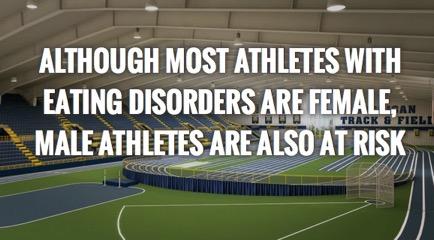Student Athletes - Body Image/Disordered Eating
Student athletes are often exposed to pressures that affect healthy eating and body image. Many are subjected to both internal and external appearance demands and a performance drive for thinness, leanness, and gender norms. This is prominent in (but not limited to) sports with appearance and form judging, such as gymnastics, figure skating, and diving, as well as weight class sports such as wrestling and light-weight rowing. Similarly, student athletes may struggle with an eating disorder or disordered eating in sports like running, swimming and soccer where the perception of athletes as naturally slender and subject to strict training routines can go unnoticed for some time. Temporarily improved performance due to weight loss can also mask an eating disorder or disordered eating symptoms, but increases the risk of injury.
Risk Factors for Student Athletes
Sports that emphasize appearance, weight requirements or muscularity
Individual sports as opposed to team sports
Endurance sports such as track and field, cross country, and swimming
Coaches who focus primarily on success and performance rather than on the athlete as a whole person
Overvalued belief that lower body weight will improve performance
Training for a sport since childhood or being an elite athleteLow self-esteem
Family dysfunction (including parents who live through the success of their child in sport)
Families with eating disorders
Chronic dieting
History of physical or sexual abuse and other traumatic life experiences
Peer, family and cultural pressures to be thin
Boost Your Body Confidence
Discipline and Dedication Versus Disordered Eating
While discipline and dedication can be important and useful in most aspects of a student athlete's life, most eating disorders start simply with a restricting diet.
Misconceptions such as "lowering body fat" vs. considering body composition (assessed by training, medical, nutrition professionals) are often closely connected to development of disordered eating and eating disorders.
The percentage of affected females is higher than for men, but disordered eating and eating disorders are on the rise for the latter. Symptoms often appear differently; male athletes may not strive for thinness, but their drive for lean muscle and being "cut" may lead to similar behaviors of disordered eating and eating disorders that often go unrecognized and untreated.
How Teammates and Coaches can Help
Don't make food and body image a focus of conversation
Encourage student-athletes to utilize the resources available to them, such as the Sport Nutritionist or a Counselor
Be willing to intervene if you are concerned, and know how to effectively speak to the issue
Focus on a positive, person-oriented coaching style rather than negative, performance-oriented coaching style
Provide support from with healthy attitudes towards size and shape
Emphasize factors that contribute to personal success such as motivation and enthusiasm rather than body weight or shape
Physical Health Consequences
Sleep disturbance
Difficulties regulating body temperature
Cardiac complications (possibly cardiac arrest and/or death)
Loss of bone density
Damage to various organs and body parts (kidneys, hair, skin, etc.)
Mental Health Consequences
Anxiety
Depression
Eating Disorders: Anorexia, Bulimia, Binge-Eating, and others

